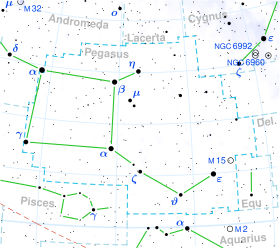
| |
| Observation data Epoch J2000 Equinox J2000 | |
|---|---|
| Constellation | Pegasus |
| Right ascension | 21 29 56.89545 |
| Declination | 23° 38′ 19.8170″ |
| Apparent magnitude (V) | 4.52 |
| Characteristics | |
| Evolutionary stage | AGB |
| Spectral type | M1+III |
| U−B color index | +1.93 |
| B−V color index | +1.62 |
| Astrometry | |
| Radial velocity (Rv) | −18.92 km/s |
| Proper motion (μ) | RA: +24.74 mas/yr Dec.: +3.63 mas/yr |
| Parallax (π) | 8.28 ± 0.18 mas |
| Distance | 394 ± 9 ly (121 ± 3 pc) |
| Absolute magnitude (MV) | −0.89 |
| Details | |
| Radius | 55 R☉ |
| Luminosity | 653 L☉ |
| Temperature | 3,919 K |
| Other designations | |
| 2 Peg, NSV 25624, BD+23°4325, FK5 1565, GC 30109, HD 204724, HIP 106140, HR 8225, SAO 89752, CCDM J21299+2338A, WDS J21299+2338A | |
| Database references | |
| SIMBAD | data |
2 Pegasi is a single star in the constellation Pegasus, located approximately 394 light years away from the Sun based on parallax. It is visible to the naked eye as a faint, red-hued star with an apparent visual magnitude of 4.52. The object is moving closer to the Earth with a heliocentric radial velocity of −19 km/s. It has a magnitude 12.7 visual companion, designated component B, at an angular separation of 30.4″.
This is an aging red giant star with a stellar classification of M1+III, currently on the asymptotic giant branch, having exhausted the hydrogen at its core and evolved away from the main sequence. The star has expanded to an estimated 55 times the radius of the Sun. It is radiating 653 times the luminosity of the Sun from its enlarged photosphere at an effective temperature of 3,919 K.
References
- ^ Van Leeuwen, F. (2007). "Validation of the new Hipparcos reduction". Astronomy and Astrophysics. 474 (2): 653–664. arXiv:0708.1752. Bibcode:2007A&A...474..653V. doi:10.1051/0004-6361:20078357. S2CID 18759600. Vizier catalog entry
- ^ Anderson, E.; Francis, Ch. (2012). "XHIP: An extended hipparcos compilation". Astronomy Letters. 38 (5): 331. arXiv:1108.4971. Bibcode:2012AstL...38..331A. doi:10.1134/S1063773712050015. S2CID 119257644. Vizier catalog entry
- ^ Eggen, O. J. (1992), "Asymptotic giant branch stars near the sun", The Astronomical Journal, 104: 275, Bibcode:1992AJ....104..275E, doi:10.1086/116239.
- ^ Hoffleit, D.; Warren, W. H. (1995). "VizieR Online Data Catalog: Bright Star Catalogue, 5th Revised Ed. (Hoffleit+, 1991)". VizieR On-line Data Catalog: V/50. Originally Published in: 1964BS....C......0H. 5050. Bibcode:1995yCat.5050....0H.
- ^ Mallama, A. (2014). "Sloan Magnitudes for the Brightest Stars". The Journal of the American Association of Variable Star Observers. 42 (2): 443. Bibcode:2014JAVSO..42..443M.Vizier catalog entry
- ^ Famaey, B.; Pourbaix, D.; Frankowski, A.; Van Eck, S.; Mayor, M.; Udry, S.; Jorissen, A. (2009). "Spectroscopic binaries among Hipparcos M giants". Astronomy and Astrophysics. 498 (2): 627. arXiv:0901.0934. Bibcode:2009A&A...498..627F. doi:10.1051/0004-6361/200810698. S2CID 18739721.
- ^ Brown, A. G. A.; et al. (Gaia collaboration) (August 2018). "Gaia Data Release 2: Summary of the contents and survey properties". Astronomy & Astrophysics. 616. A1. arXiv:1804.09365. Bibcode:2018A&A...616A...1G. doi:10.1051/0004-6361/201833051. Gaia DR2 record for this source at VizieR.
- "2 Peg". SIMBAD. Centre de données astronomiques de Strasbourg. Retrieved 2019-04-07.
- Eggleton, P. P.; Tokovinin, A. A. (September 2008). "A catalogue of multiplicity among bright stellar systems". Monthly Notices of the Royal Astronomical Society. 389 (2): 869–879. arXiv:0806.2878. Bibcode:2008MNRAS.389..869E. doi:10.1111/j.1365-2966.2008.13596.x. S2CID 14878976.
- Mason, Brian D.; Wycoff, Gary L.; Hartkopf, William I.; Douglass, Geoffrey G.; Worley, Charles E. (2001). "The 2001 US Naval Observatory Double Star CD-ROM. I. The Washington Double Star Catalog". The Astronomical Journal. 122 (6): 3466. Bibcode:2001AJ....122.3466M. doi:10.1086/323920. Vizier catalog entry
| Constellation of Pegasus | |||||||||||||
|---|---|---|---|---|---|---|---|---|---|---|---|---|---|
| Stars |
| ||||||||||||
| |||||||||||||
| Star clusters |
| ||||||||||||
| Nebulae |
| ||||||||||||
| Galaxies |
| ||||||||||||
| |||||||||||||
| |||||||||||||